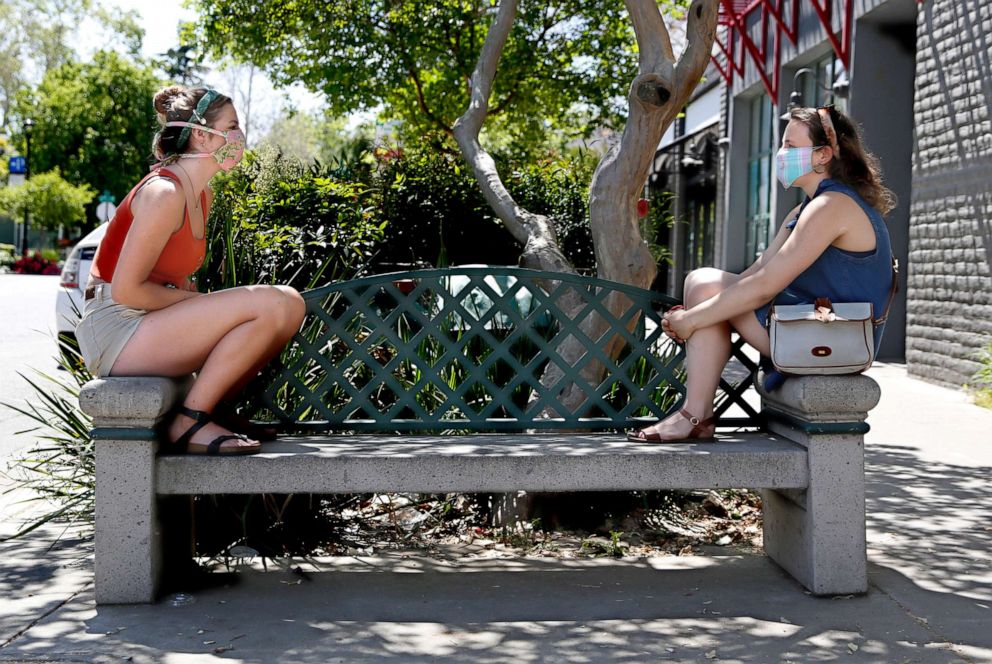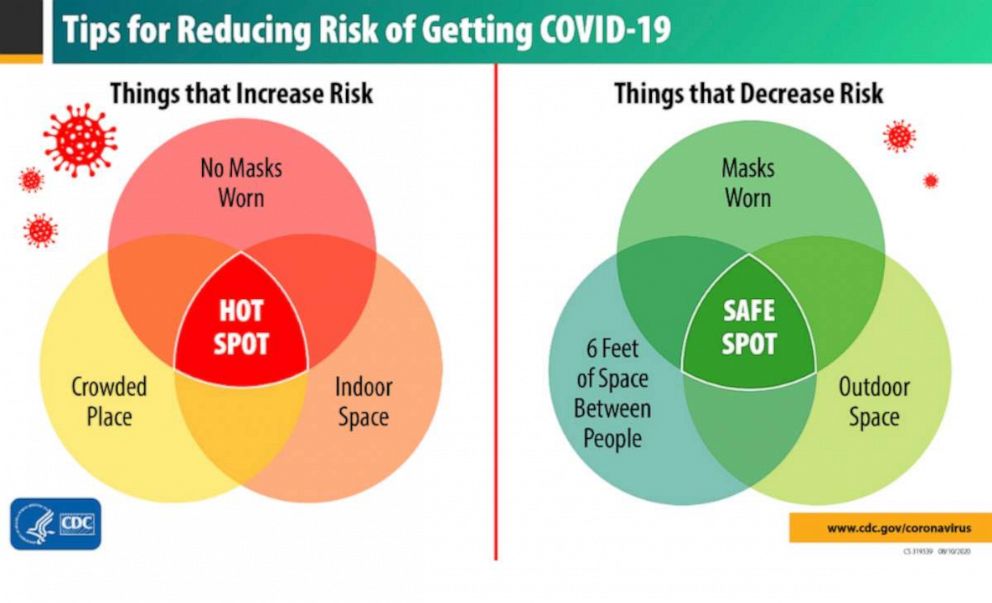经过一番反复,疾病控制和预防中心再次证实,即使人们距离感染者超过6英尺,导致新冠肺炎的病毒也可以通过空气传播,这增加了在室内聚集时佩戴口罩和适当通风的重要性。
空气传播不是病毒传播的主要方式,但疾控中心今天承认这是可能的——特别是在通风不良的室内空间。
这周一疾控中心网站的更新继上个月的批评之后代理发布的信息然后突然移除它。
公共卫生专家最初对该机构发布的信息表示欣慰符合最新的科学在…的报道中政治干预在新冠肺炎的回应中。疾病预防控制中心主任罗伯特·雷德菲尔德和其他疾病预防控制中心官员说,这种语言是在该机构完成科学审查过程之前无意中发布的,这是一个内部错误,不是外部压力的结果。
疾病预防控制中心现在表示,病毒可以以小液滴或颗粒的形式传播,这些小液滴或颗粒在空气中滞留,可能在感染者离开空间后数小时内传播。
该指南仍然强调,感染的主要风险来自与可能咳嗽或打喷嚏的感染者的密切接触,这些感染者可能携带较大的病毒液滴,或者来自表面接触病毒。
疾病预防控制中心强调了“有限的、不寻常的情况”,即病毒可以在6英尺以外的人群中传播,或者在感染者离开房间后传播。

在这张2020年7月27日的文件照片中,由于新冠肺炎疫情在德国法兰克福附近的哈瑙爆发,当地合唱团“顿中顿”(Note by Note)的成员在每周排练期间唱歌受到限制。
“今天的更新承认一些已发表的报告显示了有限的、不寻常的情况,在这些情况下,新冠肺炎病毒携带者感染了6英尺以外的其他人,或者在新冠肺炎病毒呈阳性的人离开一个地区后不久。在这些情况下,传播发生在通风不良和封闭的空间,这些空间经常涉及导致呼吸加重的活动,如唱歌或锻炼,”疾病预防控制中心说在一份声明中说。
但研究病毒如何在空气中传播的专家表示,疾控中心的指南没有充分强调近距离传播也可以通过空气中的粒子传播,特别是因为无症状的人只能通过语言传播病毒,而不是通过咳嗽或打喷嚏传播,咳嗽或打喷嚏会产生更大的粒子。
加州大学圣地亚哥分校的传染病专家罗伯特·斯库利说,这使得人们在室内和室外的人一起时戴口罩变得更加重要。
“我们花了很多时间谈论社交距离,就好像‘6英尺’是一个神奇的数字,人们只有在不能社交距离的情况下才应该戴口罩的建议,在气溶胶传播的背景下,确实是考虑不周的建议,”他周一告诉记者。

在这张2020年4月27日的档案照片中,凯蒂·菲(左)和昕薇·克什坐在加州的戴维斯市中心,练习社交距离和戴口罩。
“我们应该给人们的建议是,无论何时,当你和家人以外的人在室内时,都要戴上口罩,超越这种神奇的6英尺二分法的概念,即这种病毒的传播和其他通过空气传播的病毒的传播。正如我们本周在白宫看到的,戴口罩至关重要,”他说。
一组气溶胶粒子和传染病专家在周一发表的一封信中敦促官员们将更多关于气溶胶化的科学知识纳入公共卫生对策,称如果有症状的人呆在家里,应该更加重视保护人们免受通过室内空气的无症状传播,并适当通风,尽可能将活动和集会转移到室外。
“有大量证据表明,吸入严重急性呼吸综合征冠状病毒2型(SARS-CoV-2)是2019年(新冠肺炎)冠状病毒疾病的主要传播途径,”来自全国各地大学的六名专家在一封发表的信中写道在《科学》杂志上星期一。

疾病预防控制中心的一幅图表显示了如何通过戴口罩、与他人保持距离以及在户外或通风良好的地方度过时间来降低新冠肺炎暴露的风险。
他们说,因为防止空气传播的最重要的方法是告诉人们优先考虑室外集会或通过打开窗户等步骤改善室内通风。
“知道它在空气中,承认它在空气中,你实际上可以解决这个问题。这是一个非常容易解决的问题,”加州大学圣地亚哥分校杰出的大气化学教授金伯利·普拉瑟周一告诉记者。
这疾控中心建议与他人保持至少6英尺的距离,戴口罩,避免大型集会,尽可能在室外举行任何活动或集会。
CDC confirms COVID-19 virus can spread through airborne transmission indoors
After some back-and-forth, the Centers for Disease Control and Prevention again confirmed the virus that causes COVID-19 can be spread through airborne transmission even when people are more than 6 feet away from an infected person, increasing the importance of wearing masks and proper ventilation when gathering indoors.
Airborne transmission is not the primary way the virus spreads, but the CDC today acknowledge it is possible -- particularly in poorly ventilated, indoor spaces.
Theupdate to the CDC's website Mondayfollowed criticism last month after theagency posted informationon airborne transmission and then abruptly removed it.
Public health experts had initially expressed relief the agency was posting information thatmatched the latest scienceamid reports ofpolitical interferencein the COVID-19 response. CDC Director Robert Redfield and other CDC officials have said the language was posted accidentally before it finished the agency's scientific review process and that it was an internal error, not a result of outside pressure.
The CDC now says the virus can spread in small droplets or particles that linger in the air, potentially for hours after an infected person has left the space.
The guidance still emphasizes that the primary risk of infection is from coming in close contact with an infected person who could cough or sneeze larger droplets carrying the virus, or from exposure to the virus on surfaces.
The CDC emphasized "limited, uncommon circumstances" when the virus can spread among people more than 6 feet away or after an infected person left the room.
In this July 27, 2020, file photo, members of the local choir "Ton in Ton" (Note by Note) sing during the weekly rehearsal under restrictions due to the outbreak of COVID-19 in Hanau near Frankfurt, Germany.
"Today's update acknowledges the existence of some published reports showing limited, uncommon circumstances where people with COVID-19 infected others who were more than 6 feet away or shortly after the COVID-19-positive person left an area. In these instances, transmission occurred in poorly ventilated and enclosed spaces that often involved activities that caused heavier breathing, like singing or exercise," the CDCsaid in a statement.
But experts in how viruses can travel through the air say the CDC guidance doesn't emphasize enough that transmission at close range can also be through airborne particles, especially since asymptomatic individuals could be spreading the virus only through speech and not the coughing or sneezing that would create larger particles.
Robert Schooley, an infectious disease specialist at the University of California, San Diego, said this makes it even more important for people to wear masks when indoors with people outside your household.
"We've spent a lot of time talking about social distancing as if '6 feet' is a magic number, and the advice people should wear masks only if they can't socially distance is really very poorly thought out advice in the context of aerosol spread," he told reporters on Monday.
In this April 27, 2020, file photo, Catie Fee, left, and Vivi Kirsh, practice social distancing and wear face masks as they sit in downtown Davis, Calif.
"The advice we should be giving people is to wear a mask whenever you're indoors with someone other than your family and move beyond this concept of a magic 6-foot dichotomy of the spread of this virus and the spread of other viruses spread by airborne transmission. As we've seen this week at the White House wearing masks is critical," he said.
A group of experts in aerosolized particles and infectious diseases urged officials to incorporate more of the science on aerosolization into the public health response in a letter published Monday, saying that if symptomatic people are staying home, there should be more emphasis on protecting people from asymptomatic spread through indoor air with proper ventilation and moving events and gatherings outside whenever possible.
"There is overwhelming evidence that inhalation of severe acute respiratory syndrome coronavirus 2 (SARS-CoV-2) represents a major transmission route for coronavirus disease 2019 (COVID-19)," six experts from universities around the country wrote in a letter publishedin the journal Scienceon Monday.
A CDC graphic shows how to reduce risk of COVID-19 exposure from wearing masks, maintaining distance from others, and spending time outside or in well ventilated areas.
They say that because the most important ways to prevent airborne transmission are by telling people to prioritize outdoor gatherings or improve ventilation indoors with steps like opening windows.
"Knowing it's in the air, acknowledging it's in the air, you can actually fix this problem. It's a very fixable problem," Kimberly Prather, Distinguished Professor of Atmospheric Chemistry at UC San Diego, told reporters on Monday.
TheCDC recommendsmaintaining a distance of at least 6 feet from others, wearing a face mask, avoiding large gatherings and conducting any event or gathering outside as much as possible.






